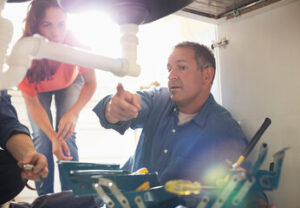If you notice a puddle or wet spots on the ceiling, walls, or floors, this is a sign that there is a leak in your pipes. Leaks should be addressed immediately to minimize water damage and costly repairs.

Pro Plumbing Orillia involves the installation and maintenance of water and waste disposal systems in buildings. It also includes adhering to building codes and regulations.
The plumbing system in your home is crucial to your health and comfort. It provides clean water for drinking and cooking, and removes waste to maintain a hygienic environment. Without regular plumbing maintenance, however, your home could be at risk of serious problems like leaks, clogs, and flooding. These issues can be costly and disrupt your daily routine. Fortunately, there are professional plumbers who can keep your plumbing system in good condition and prevent expensive repairs.
A plumbing system consists of a network of pipes that connect all the fixtures in your house to each other. This includes the water supply line that brings in freshwater from the municipal water system, the distribution pipe that branches off into individual pipes for sinks, toilets, and showers, and the drainage pipe that carries away wastewater. The pipes are made from a variety of materials, including copper, PVC, and PEX. They are joined together by fittings such as elbows, tees, and couplings.
The Environmental Protection Agency (EPA) sets standards and regulations for plumbing systems. These guidelines cover the safety and quality of drinking water, backflow prevention, and more. The EPA also ensures that plumbing systems are designed and installed properly. This helps protect public health and the environment, while also allowing people to get the most out of their water heaters and other fixtures.
Plumbers install and repair plumbing systems
Plumbing systems comprise pipes that supply water and gas to, and remove waste from, residential and commercial buildings. Plumbers are responsible for the installation, maintenance, and repair of these systems in homes, schools, hospitals, offices, and other buildings. They use a variety of tools and techniques to fix problems, such as leaks, blockages, and damaged pipes. Plumbers must also adhere to local building codes and safety standards when installing and repairing systems.
Plumbers often work in residential settings, where they install and repair kitchen faucets, toilets, bathtubs, showers, and other fixtures. They may also work on larger-scale projects, such as sewage systems, drainage lines, and heating and cooling systems. In these situations, they must collaborate with architects and construction teams to ensure that the plumbing system integrates properly into the overall infrastructure.
A career as a plumber offers many benefits, including excellent job security and good pay. It is also a rewarding job for people who enjoy working with their hands and solving problems. Moreover, it can be an ideal choice for those who want to be self-employed or start their own business. However, it is important to note that this profession involves working with dangerous chemicals and sewage. Plumbers must adhere to strict safety protocols and wear proper protective gear when working with these materials. They also need to obtain permits and undergo inspections before starting their work.
Plumbers adhere to the International Plumbing Code (IPC)
Plumbing codes and standards provide important safeguards to protect public health and safety. They also serve to promote energy efficiency and environmental sustainability. It is critical that plumbers understand and comply with these guidelines to ensure the quality and reliability of their work.
The IPC provides a comprehensive framework of rules that governs the design, installation, and inspection of plumbing systems. It establishes minimum requirements for pipes, fixtures, and appliances to protect against cross-connection contamination and backflow. It also regulates the use of new technology and materials, ensuring that plumbing products meet stringent safety and performance standards.
This code is updated on a three-year basis, and it’s widely adopted by state and local jurisdictions across the country. It can be challenging to keep up with changes in this complex document, but there are several resources that can help. Government websites, professional associations, and online publications can provide up-to-date information on the latest regulations.
A residential renovation project can require a lot of work, including updating plumbing systems. A plumber may have to install backflow prevention devices, new drains, and water-efficient appliances. In addition, they may need to update the venting system to prevent odors and ensure proper air circulation. The 2021 version of the IPC includes enhanced provisions for water efficiency and backflow prevention, as well as new materials and testing methods for piping. These changes will reduce the cost of construction, improve home and building value, and increase safety.
Plumbers install and repair water heaters
When installing or replacing a water heater, plumbers follow the Universal Plumbing Code (UPC), which sets standards for drain lines, sewage systems, and water heaters. This code is designed to protect the public health and promote environmental sustainability. The UPC also regulates the maximum temperature of a water heater and requires all new water heaters to be energy efficient.
Before starting any work on a water heater, plumbers shut off the power to the unit by turning off the circuit breaker in your service panel. They then use a garden hose to drain the old tank, and then disconnect the water line from the valve on the bottom of the unit. They may also need to turn off the gas supply to prevent explosions during the process.
Once the old water heater is removed, plumbers install the new one. They start by attaching the water and electricity supply connections, then turn on the gas and test for any leaks. They also make sure that the water heater is located in a safe place and close to a wall to avoid leaks and fire hazards.
Plumbers are required to wear personal protective equipment, including gloves, safety glasses, steel-toed boots, and ear protection when working with dangerous chemicals or tools. They must also adhere to lockout/tagout procedures when working in a hazardous area. In addition, plumbers must continue their education to keep up with the latest technologies and industry standards.
Plumbers repair leaks and clogs
A plumbing career involves a lot of hands-on work, and it’s also relatively dangerous. Therefore, you should ensure that you have the proper safety equipment and follow strict work practices. These include wearing personal protective equipment like gloves and safety glasses, using ear protection in noisy environments, and following lockout/tagout procedures to ensure that systems are de-energized before starting repairs. These measures help minimize accidents and injuries.
Clogs are caused by food scraps, soap scum, hair, and other insoluble matter that accumulates in the drain or pipe. The most common clogs occur in toilets, bathtubs, and sinks. Sometimes, these clogs can be resolved with simple tools like a plunger or plumber’s snake. However, more serious blockages can cause water damage and require professional attention.
Leaks are another common plumbing issue. These can be caused by old pipes, faulty fixtures, or a cracked water heater. If left untreated, leaks can lead to flooding, mold growth, and expensive water bills. Plumbers use a variety of techniques to repair leaks, including patching and replacing parts.
As a plumber, you’ll need to have a blend of DIY savvy and expert insight to handle the most challenging plumbing issues. By learning how to identify serious problems and when to call a professional, you can keep your home plumbing system working properly. Soft skills are also important for this career, including critical thinking, verbal communication, and teamwork.
Plumbers install and repair fixtures
When it comes to plumbing fixtures, you have many options. Choosing the right ones will ensure that your home’s plumbing systems remain functional and attractive. You can find a wide range of fixtures at your local hardware store or online. Some of them may have innovative features that can take your bathroom or kitchen to the next level. However, installing these fixtures requires careful planning and preparation. To start with, it’s best to buy more supplies than you think you’ll need. This will prevent you from running out of materials in the middle of a project. Also, remember to keep all your tools and materials in one place. This will avoid wasting time searching for a lost tool and will save you from having to repeat steps that require the use of different tools.
Plumbers install and repair the pipes that supply water to, and carry waste away from, homes and businesses. They also repair faucets, showers, tubs, toilets, and appliances like dishwashers and washing machines. They read blueprints and building codes to plan and execute installations, and they inspect work to ensure it meets health and safety standards.
Plumbers must also adhere to the International Plumbing Code (IPC). This code regulates the design, installation, and maintenance of plumbing systems in buildings and other structures. It also promotes sustainability by limiting water usage and providing water-saving fixtures. In addition to adherence to the IPC, plumbers must also follow safety protocols when working with dangerous materials or in confined spaces.




